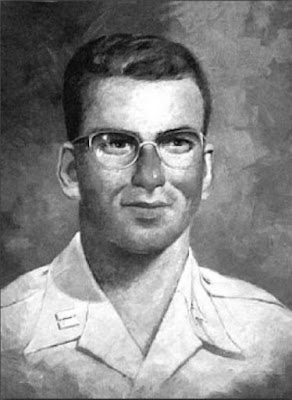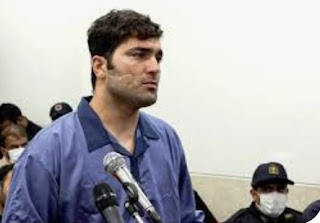The Japanese bury Chinese prisoners alive. The Sino-Japanese War, 1937.
Japanese democide-mass murder. Here is shown Chinese prisoners about to be buried alive by Japanese soldiers. Overall, in China during the Second Sino-Japanese War and World War II into which it was merged, the Japanese murdered almost 4,000,000 Chinese and over 2,000,000 others--about 6,000,000 in total
In December of 1937, the Japanese Imperial Army marched into China's capital city of Nanking and proceeded to murder 300,000 out of 600,000 civilians and soldiers in the city. The six weeks of carnage would become known as the Rape of Nanking and represented the single worst atrocity during the World War II era in either the European or Pacific theaters of war.
The actual military invasion of Nanking was preceded by a tough battle at Shanghai that began in the summer of 1937. Chinese forces there put up surprisingly stiff resistance against the Japanese Army which had expected an easy victory in China. The Japanese had even bragged they would conquer all of China in just three months. The stubborn resistance by the Chinese troops upset that timetable, with the battle dragging on through the summer into late fall. This infuriated the Japanese and whetted their appetite for the revenge that was to follow at Nanking.
After finally defeating the Chinese at Shanghai in November, 50,000 Japanese soldiers then marched on toward Nanking. Unlike the troops at Shanghai, Chinese soldiers at Nanking were poorly led and loosely organized. Although they greatly outnumbered the Japanese and had plenty of ammunition, they withered under the ferocity of the Japanese attack, then engaged in a chaotic retreat. After just four days of fighting, Japanese troops smashed into the city on December 13, 1937, with orders issued to "kill all captives."
Their first concern was to eliminate any threat from the 90,000 Chinese soldiers who surrendered. To the Japanese, surrender was an unthinkable act of cowardice and the ultimate violation of the rigid code of military honor drilled into them from childhood onward. Thus they looked upon Chinese POWs with utter contempt, viewing them as less than human, unworthy of life.
In December of 1937, the Japanese Imperial Army marched into China's capital city of Nanking and proceeded to murder 300,000 out of 600,000 civilians and soldiers in the city. The six weeks of carnage would become known as the Rape of Nanking and represented the single worst atrocity during the World War II era in either the European or Pacific theaters of war
The actual military invasion of Nanking was preceded by a tough battle at Shanghai that began in the summer of 1937. Chinese forces there put up surprisingly stiff resistance against the Japanese Army which had expected an easy victory in China. The Japanese had even bragged they would conquer all of China in just three months. The stubborn resistance by the Chinese troops upset that timetable, with the battle dragging on through the summer into late fall. This infuriated the Japanese and whetted their appetite for the revenge that was to follow at Nanking.After finally defeating the Chinese at Shanghai in November, 50,000 Japanese soldiers then marched on toward Nanking. Unlike the troops at Shanghai, Chinese soldiers at Nanking were poorly led and loosely organized. Although they greatly outnumbered the Japanese and had plenty of ammunition, they withered under the ferocity of the Japanese attack, then engaged in a chaotic retreat. After just four days of fighting, Japanese troops smashed into the city on December 13, 1937, with orders issued to "kill all captives."
Their first concern was to eliminate any threat from the 90,000 Chinese soldiers who surrendered. To the Japanese, surrender was an unthinkable act of In December of 1937, the Japanese Imperial Army marched into China's capital city of Nanking and proceeded to murder 300,000 out of 600,000 civilians and soldiers in the city. The six weeks of carnage would become known as the Rape of Nanking and represented the single worst atrocity during the World War II era in either the European or Pacific theaters of war.The actual military invasion of Nanking was preceded by a tough battle at Shanghai that began in the summer of 1937. Chinese forces there put up surprisingly stiff resistance against the Japanese Army which had expected an easy victory in China. The Japanese had even bragged they would conquer all of China in just three months. The stubborn resistance by the Chinese troops upset that timetable, with the battle dragging on through the summer into late fall. This infuriated the Japanese and whetted their appetite for the revenge that was to follow at Nanking.
After finally defeating the Chinese at Shanghai in November, 50,000 Japanese soldiers then marched on toward Nanking. Unlike the troops at Shanghai, Chinese soldiers at Nanking were poorly led and loosely organized. Although they greatly outnumbered the Japanese and had plenty of ammunition, they withered under the ferocity of the Japanese attack, then engaged in a chaotic retreat. After just four days of fighting, Japanese troops smashed into the city on December 13, 1937, with orders issued to "kill all captives."Their first concern was to eliminate any threat from the 90,000 Chinese soldiers who surrendered. To the Japanese, surrender was an unthinkable act of cowardice and the ultimate violation of the rigid code of military honor drilled into them from childhood onward. Thus they looked upon Chinese POWs with utter contempt, viewing them as less than human, unworthy of life. the ultimate violation of the rigid code of military honor drilled into them from childhood onward. Thus they looked upon Chinese POWs with utter contempt, viewing them as less than human, unworthy of life.
Thanks for reading leave your thoughts in the comments section below
Read more on our Rare History Channel
















Comments
Post a Comment